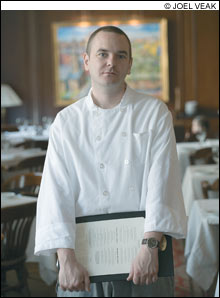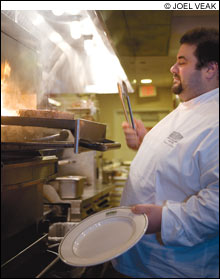Meat
We may scream for ice cream and go cuckoo for Cocoa Puffs, but we beat our breasts for meat, the source of perhaps our most primitive cravings. That goes double for you guys — hard-wired (and hard-bodied) as you are to relish the hunt, to harbor a bloodlust for your prey (which might otherwise become predator). But in a city as uber-civilized, health-conscious, and cramped as ours —where the buffalo don’t roam (but the veggie activists do) and even space for a proper grill is scarce — well, it’s hard out here for a carnivore. With this compilation of tips from local meat mavens, we’re just trying to make it all a little easier.Ordering it: from butcher shops to chop-houses

Grill 23's Jay Murray |
"When people come to a steak house," says Ruth’s Chris Steak House GM Domenic D’Olimpio, "the first thing they’re going to look at is the filet. " He’s right: loin cuts are no-brainers. Your filet mignons, your T-bones, your New York strips — these are the most tender (and among the leanest) cuts, hence the easiest to prepare: the less you mess with them, the better. According to butcher Ron Savenor of Beacon Hill (and now Cambridge) institution Savenor’s, you should place your order with just two key factors in mind. The first is bright-red color. That indicates the meat is fresh, freshly cut. Beyond that, probably the most important thing is the marbling, which dictates how well it’s going to eat. That’s the oleaginous unsaturated fat. Contrary to what the world believes, that’s actually the good cholesterol. People see marbling and they think, ‘Oh, that’s terrible,’ and it’s not. "But wait. If the loins are so lean, won’t they have less marbling? Bingo, beef-brainiac. Tenderness, though a virtue in itself, is not synonymous with flavor. In fact, among the threads that run through our conversations with the experts, one of the most common concerns the merits of humbler cuts. Says Savenor, "People come in and say, ‘I only eat sirloin,’ or ‘I only eat tenderloin.’ My advice is, try different cuts and different recipes."
Jay Murray, executive chef at Grill 23, blames industry conglomerates for the loin bias —which it has been in their best interest to shape through marketing. After all, lesser-known cuts "require more effort to produce. If they want to process 600 heads of cattle a day, they can’t be cutting you flatiron steaks." And those happen to be favorites of Murray’s: "It’s probably the most flavorful or second most flavorful steak in the entire animal. We were trying some here one night and I thought, ‘What is that flavor?’ And then I realized it tasted like squab. It was gamey but sweet; it wasn’t livery. Of course, sometimes I just want a fatty taste explosion, and then I go for the skirt steak. With every bite you just want to sit back and go, ‘Uhh.’ "
That said, if you’re going to splurge, do it right. Former chef and current Morton’s general manager Scott Crain personally recommends the New York strip ($43), "cooked to a perfect medium-rare, with a nice char on the outside but just unbelievably tender and flavorful on the inside." Okay, granted, "if your thing is to have it well-done with ketchup, you’re going to get it well-done with ketchup. I’m from the South, and my dad would be number one. But the only caveat we have with guests is we say, ‘If you want it well-done, we suggest that we cook it medium-well. When it arrives, if you need for us to bring up the temperature a little more, that’s what we’ll try to do. But once it gets to well-done, it can’t go back.’"
Bonus Tip: Speaking of New York strips: the Palm’s signature Steak à la Stone ($38.50) puts a nifty twist on the straight-forward sirloin by slicing it up and serving it on toast points, smothered in peppers and onions.
Bonus Tip: Leery of a little old lamb? Don’t be. According to Smith & Wollensky chef Tindaro LoSurdo, "If you can get a good domestic rack of lamb, it’s very sweet. It doesn’t have so much gaminess like [those from] New Zealand."
Cooking: from seasoning to searing

Smith & Wollensky's Tindaro LoSurdo |
Different cuts have different flavors, and they all require slightly different cooking methods, " says Savenor’s Ron Savenor. For instance, "generally the cuts that require marinating are the shoulder cuts, the most used muscles —which have a really nice flavor" that’s only enhanced by tenderization. (Acid usually constitutes the active ingredient in a marinade, be it wine, vinegar, or citrus.) Excepting the toughest cuts, says Tindaro LoSurdo, "I personally prefer dry rubs with roasted garlic. You can use garlic powder, onion powder, cumin if you want a little South western flair. Turmeric is always good — it gives a nice smoky kind of flavor. Paprika gives a smoky flavor, too." Meanwhile, roast the garlic "so it’s brown and soft, nice and smushy; add that to the spices, mix it all together, and then rub it on the steak. What happens when grill it is, it gets that nice, garlicky, charred flavor on the outside."LoSurdo’s advice dovetails nicely with that of Murray, who says that "the biggest mistake people make when cooking beef is they don’t season it enough before they cook it. It’s a myth that [pre-seasoning] dries out the meat. Here [at Grill 23], we stake our reputation on letting the meat dry out for four weeks before we serve it. So how can it hurt the meat to salt it before you cook it?" In fact, he adds, salt "draws the proteins to the surface, so when you give [the meat] a sear, they caramelize and lock in the flavor. If you salt it after you get a crust on it, the salt just sort of bounces around. "
Savenor, on the other hand, considers overcooking blunder number one. "My opinion is everything should be cooked rare. Not raw, but rare." And while he recommends that novices determine desired doneness with a meat thermometer, "personally, I like to teach ‘the poke.’... I remember watching Michael Schlow do it and thinking, ‘I’m going to get this poke thing down.’" As Savenor describes it, if you turn your palm towards you and touch that little squishy piece of skin "between your thumb and forefinger, you’ll have a model for the texture of rare meat. Below that, where the muscles themselves meet, that’s medium-rare." And well-done would be the outside part of your thumb, closer to your wrist.
The method applies to all meats, of course; according to LoSurdo, pork in particular may merit a poke. "I love a pork porterhouse done medium, medium-rare. The old rule about cooking [pork] all the way through — that doesn’t necessarily have to happen anymore It’s safe now, and as with anything, if you don’t overcook it, you keep the flavor in there." (Disclaimer: don’t try pork tartare at home.) He points out that, after all, the classic pairing of pork with fruit actually "stems from the problem of overcooking. You give pork some apple-sauce, it adds sweetness to something that’s usually dry. Still, LoSurdo gives the duo its due. The lingering flavor of some fruit sauces helps cut the fattiness of the pork; it rounds out the dish. Apples are always good, but I also like grilled peaches and pears."
The same goes for lamb and game. Explains LoSurdo, "People are a little afraid of their pronounced aftertaste; what the fruit sauces tend to do is kill that lingering flavor and finish off the palate. With respect to the former, We make a mint sauce here with orange peel. The whole lamb-mint combination was originally a Middle Eastern thing" — take that, Anglophiles— "and they do complement each other very well." Regarding less familiar, hence more intimidating, game, LoSurdo advises you above all to relax. "Just follow the basic rules of cooking. Boar’s in the pig family, so whatever you like to do with pork, do that, keeping in mind it’s going to have a stronger taste. I think what’s most important is to have a good time. If you make venison chops and they stink, you can always call a Chinese place.”
Bonus Tip: Perhaps inadvertently, the Ruth’s Chris Web site makes cooking a proper steak nearly as easy as booking a table at the restaurant. Check out the chophouse chain’s handy guide to deter-mining doneness at www.ruthschris.com/steak/doneness.html
Bonus Tip: John Dewar & Co.’s Web site (www.johndewarinc.com) also boasts a bounty of info for the eager amateur, from anatomical diagrams depicting the source of each cut to recipes and charts for such daunting dishes as standing rib roast, rack of lamb, and holiday turkey.
Eating it: from sides to sips

Morton's Scott Crain |
Be it a humble home-cooked meal or a sumptuous steak-house spread, there’s more to a good chop dinner than the chops themselves. Take side dishes. For the most part "they’re inter-changeable," as Jay Murray puts it — so it’s no faux pas to eschew the baked potato, creamed spinach, or grilled asparagus in favor of some-thing like the Met Club’s smashed sweet potato with brown sugar and pecans ($7) or Bonfire’s tempura green beans with truffle aioli ($6).Meanwhile, Morton’s Scott Crain has some intriguing suggestions for lamb. "Our caramelized onions with mushrooms are served in a kind of jus that’s intense with thyme, which is a very good flavor for lamb. We also just started serving mashed potatoes with a garlic butter made with anchovies and Pernod, which is an anise liqueur whose flavor accentuates what lamb is all about." Finally, he adds, "I know it’s hard for people here to imagine, but we have an absolutely fantastic Australian rock-lobster tail. We serve ’em on the side, so you could do a different kind of surf-and-turf with lamb and rock lobster. "
As for wine, we have some refreshing news: the big reds are slowly loosening their strangle-hold on your steak dinner. Mind you, bold red wine with red meat is a classic pairing for good reason: as Crain puts it, "tannins really accentuate the charred flavor of steak." But there are equally good reasons to make other choices. Murray claims to prefer white wine as a counterbalance to the richness of steak. "I like something with pretty crisp acidity, like a pinot gris or a riesling." (By the same token, Murray implores diners who "are never going to get over" their red fetish to at least try something "brighter, like a grenache. You can’t get much brighter than that.")
LoSurdo concurs, using as an example his favorite Smith & Wollensky dish, the veal chop ($38), which is simply broiled and served with garlicky sauteed spinach and veal jus. "I like white wine with veal. I do. I like sauvignon blanc, chardonnay, pinot gris. In cooking school, they teach you about concentrating on finish when it comes to pairing. With something as soft as veal, a wine that lingers too long will take away from the flavor of the meat. But the finish of a wine like a sauvignon blanc is very crisp. And the crispness cuts right through the fat. That combination of crisp finish and fatty veal is great — [neither] takes away from the flavor of [the other]." Asked about lamb, LoSurdo shrugs." People say if you’re gonna have lamb, have pinot noir because it has the[requisite] fruit. It all goes back to finishing the palate — and, in turn, polishing off that perfect pile of protein on your plate.
Bonus Tip: How does mushroom-chevre ravioli or ham-and-cheese gnocchi grab you? Grill 23’s Prime Beef Weekly Cuts Menu abounds with clever trimmings. Says Murray, "My dream when I introduced [the menu] was to get people to mix and match[cuts and sides], so they’d get to try ’em all in a way that they like."
Bonus Tip: For a happy medium between bare-bones barbecue joints and budget-blowing steak houses, consider haunts like Tremont 647 and East Coast Grill, whose longevity may very well be chalked up to the celebrated grilling expertise of respective chef-owners Andy Husbands and Chris Schlesinger.